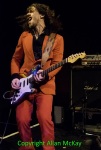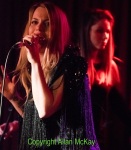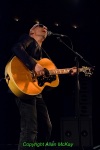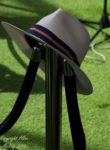 This started the way the best features do, as a conversation in the pub. We’ll let Allan take it from there.
This started the way the best features do, as a conversation in the pub. We’ll let Allan take it from there.
It’s one of the oldest tricks in the pop music book; if the song’s on its last legs and you still need another thirty seconds or so to get you up to the optimal time for radio play, then you deploy one the producer’s most potent tactical weapons – the trucker’s gear change. In its most basic form, the whole arrangement shifts up a tone or a semitone, to grab back your attention before the chorus repeats and fades. Usually, it just happens once, but that depends on how desperate you are (or how weak the song is). You might even get some clever stuff going on to get from one key to the next; when that happens, you get all classical and call it a modulation. What do they sound like? Let’s start with an absolute clunker.
“I Will Always Love You” – Whitney Houston
Considering the quality of the musicians available to producer David Foster, this TGC is bone-jarringly unsubtle; there’s no attempt to pretty it up by repeating a riff in the new key or moving through a few passing chords. Oh no; old key/bang/new key – we’re done. As if that’s not enough, there’s a whole bar of almost complete silence before the melody crashes back in again, maybe David Foster thought that the average listener couldn’t remember which key the song was in after 4 beats. Who knows; anyway it’s a crash/bang/wallop of the highest order and you can hear the teeth grinding off the flywheel:
“Love on Top” – Beyonce
OK, we’re now well and truly in the era of digital recording and production and it’s much easier and quicker to manipulate sounds. You can do a TGC with a mouse-click. If it’s so easy to do, why not do loads of them – one is good, two must be better. Beyonce co-produced this with Shea Taylor, so she’s sharing the blame here. In the last ninety seconds of the radio edit there are four, yes four upward key shifts as the chorus is repeated. It makes you wonder what it would be like if the key shift just kept repeating. As it happens, someone thought of that. Here it is with fourteen upward shifts:
“The Snake” – Al Wilson
Ah, the old Northern Soul classic. Fans will remember that one of the UK pressings of this song had a cover of the John Fogerty classic “Lodi” on the b-side. That’s not relevant, just me showing off. Sometimes you can get away with a few stick shifts if you’re building up to the climax of the song and that’s what happens here. At the end of the second verse, there’s a bass riff which is then repeated a tone higher and you’re in a different key. It’s not just a chorus repeated in exactly the same way but higher, it’s part of the process of moving the story along. And the same device is repeated at the end of the third chorus into the final verse as the song reaches its dramatic finale. Maybe I’m biased, but I think this is part of the arrangement of the song and that keeps it out of Room 101:
“Heat Treatment” – Graham Parker & the Rumour
You might think that any key change part way through a song would be agreed with the writer; it ain’t necessarily so. This was the title song of GP and the Rumour’s second album “Heat Treatment”, released in 1976, the same year as his debut “Howlin’ Wind” (two albums in a year and incessant gigs; musicians grafted in those days). Partway through the song, there’s a modulation; it’s quite musical – a two-bar horn section phrase takes the song up a tone. It’s not lumpy but it does the job fairly quickly. The problem is that it’s not part of generating extra excitement, just the opposite. It takes the song into a bass riff breakdown and the groove has to be built up again from scratch. Graham Parker made his feelings about it known when the album was remastered for CD; his sleeve notes refer to it as ‘that abusive key change’. Fair enough.
“Up the Junction” – Squeeze
This was the title track from the second Squeeze album, with a tip of the hat to Nell Dunn who wrote the novella of the same name. Glenn Tilbrook and Chris Difford were just beginning to realise their potential as songwriters and Jools Holland was still their keyboard player. This is a key change that is about as far from a trucker’s gear change as you can get. It’s a modulation that reflects a downbeat turn in the lyrics through a ten-bar bridge using minor chords before dropping a whole tone for a more upbeat verse and then, paradoxically, going back up by a whole tone for the downbeat final verse. Difford and Tilbrook characteristically messing with the conventions. Bits of “Up the Junction” trivia? There are no choruses and the title of the song doesn’t appear in the lyric until the last three words:
Allan was a bit chuffed to get his first big festival photo accreditation this summer for Cornbury Festival in Oxfordshire. It was perfectly timed to coincide with a complete weekend shutdown of rail services through Oxford during the hottest weekend but it takes a lot more than that to stop a determined photographer. When he eventually made it there, well, we’ll let him tell you about it.
OK, Friday night and the first band to play in the dark with stage lights was Stereo MCs. Had to be done really. It was a bit of a nostalgia thing; loads of memories of my DJ days in the late eighties/early nineties. From the outset, it was obvious that Rob Birch is still a hugely charismatic and dynamic frontman. I think this just about captures it:
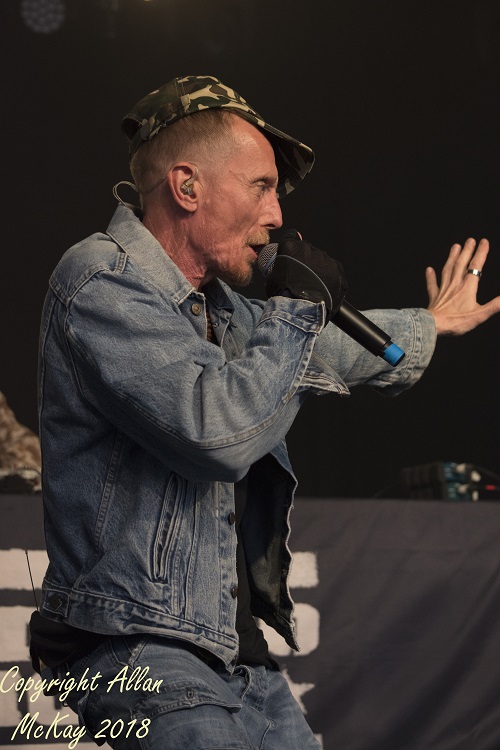
Last set on Friday night was UB40. I saw UB40 on their first national tour when they supported The Pretenders on tour across the UK in 1980. They were fired up, they wanted to succeed and they sounded amazing. Nearly forty years on, it’s a very different story; there are two UB40s touring and neither’s convincing. This version is pretty pedestrian, but they have one secret weapon – Brian Travers. I’m sure he wouldn’t claim to be the best sax player in the world, but he knows how to sell it:
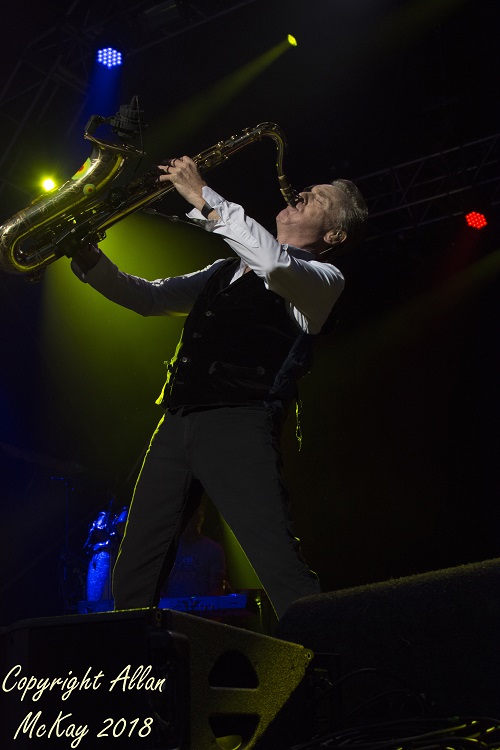
Saturday night was busy (although Alanis Morissette decided not to allow any press access for her set) and the Songbird Stage was the place to be. Obviously Mavis Staples was a do-not-miss, but PP Arnold was another. You would think she’d never been away; she sounded fabulous and looked like this:
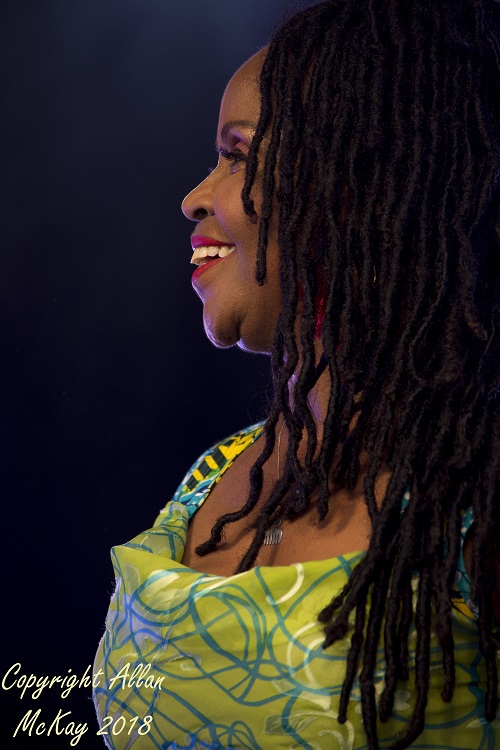
Sunday afternoon on the Pleasant Valley Stage; anyone for a bit of Deacon Blue? Definitely; I saw them a couple of times in the very early days and I loved them. It’s partly a Scottish thing, but it’s mainly a music thing. They have great songs and they have the experience to sell them on a festival stage. You never know, Ricky might do a bit of politics. Actually you do know, he will. Anyway, he’s looking pretty pumped these days:
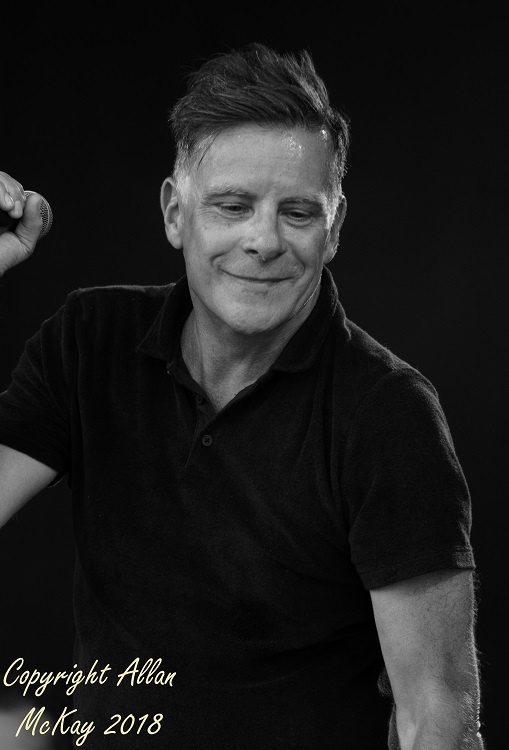
Sunday evening headliners – Squeeze. We go back a long way; I saw Squeeze for the first time at Dundee University Students’ Association; there were more people on stage than in the audience and it was still a great gig. I’ve photographed them on occasions forty years apart (I know, I don’t look that old) and I still love those Difford/Tilbrook songs. This time, it was Yolanda Charles that really caught my eye:
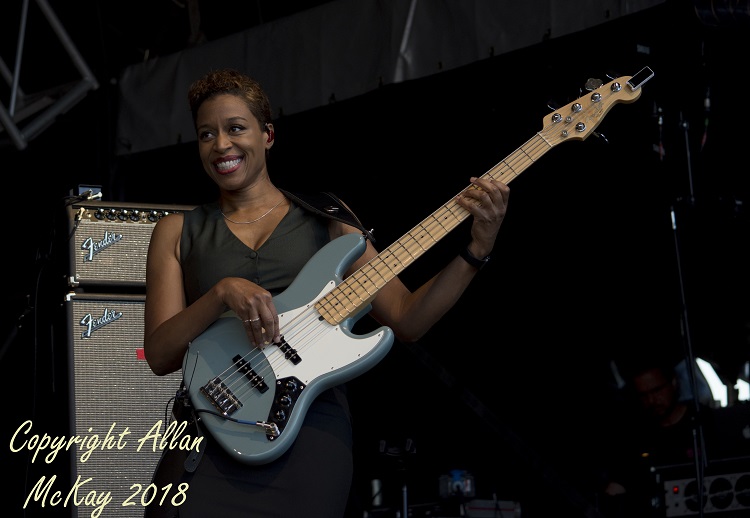
 Musicians love making jokes about each other; we’ve all heard the drummer jokes. Another old chestnut was the line about parking next to the banjo player’s Porsche. OK, they might not be driving Barbie-magnets yet, but, with the rise of Americana, the banjo’s regaining a lot of credibility. Personally. I’d rather hear a banjo than a ukulele any day of the week. In the hands of a maestro like Chicagoan Al Scorch, the banjo takes on a whole new character. It transforms from the kid that no-one would pick for the football team to a menacing, sneering, leather-jacketed Brando in “On the Waterfront”.
Musicians love making jokes about each other; we’ve all heard the drummer jokes. Another old chestnut was the line about parking next to the banjo player’s Porsche. OK, they might not be driving Barbie-magnets yet, but, with the rise of Americana, the banjo’s regaining a lot of credibility. Personally. I’d rather hear a banjo than a ukulele any day of the week. In the hands of a maestro like Chicagoan Al Scorch, the banjo takes on a whole new character. It transforms from the kid that no-one would pick for the football team to a menacing, sneering, leather-jacketed Brando in “On the Waterfront”.
But, before I get too carried away with Al Scorch, what about some context? I was visiting Songwriters’ Night at The famous Troubadour in Earl’s Court with an element of trepidation. On my last visit eight months ago, most of the audience talked non-stop throughout the evening, drowning out some very good but quiet singer-songwriters. No such problems this time; as soon as the performers walked on stage, every conversation stopped.
First on stage was Freja Frances (or just Freja) who played a set of delicate, almost fragile, but ethereal, introspective piano-backed ballads. A few nerves, maybe, but belief in the strength of the material pulled her through, helped by respectful silence from the audience. You can hear two of the songs she played on the night, “Papercuts” and “Porcelain Doll” on Soundcloud; they’re well worth hearing.
Miles Horn ramped up the tempo and the volume a few notches with electric guitar backing (plus a couple of songs at the piano) as he ran through a set of melodic and introspective songs starting with “The Great Abyss”. His voice is strong (although he admitted that the falsetto in “Why Don’t You Love Me” was a bit misjudged) and combined with his interesting guitar style and original melodies hints at Squeeze’s Glenn Tilbrook (never a bad thing in my opinion). He’s very assured on stage and, apart from the one mistake with a new song (which he predicted in advance), the set was spot-on, creating a rapport with the audience and giving some background to the songs. Have a listen to “Something Beautiful” and “Slow Motion” here.
Al Scorch and fiddle player Jess McIntosh were something else. They’d brought along a strong following from earlier in their UK tour, but they could have generated audience participation in a mortuary. They’re both very fine players who bring a very punk approach and huge amounts of energy to traditional instruments, creating a buzz from the opening of “Pennsylvania Turnpike” to the close of the set, which was based mainly around Al’s superb new album “Circle Round the Signs”, featuring “Lonesome Low”, “City Lullaby”, “Lost at Sea”, “Everybody Out”, “Insomnia” and “City Lullaby” plus a few others including the poignant “Two Flags” and the crowd favourite “Little Dog”. Both players are lively, but Al is a one-man whirlwind, stomping around the stage, stamping his feet in time and shouting out his declamatory and inflammatory lyrics. By the end of the set, following a banjo and fiddle version of the extended live rock song ending, the performers were running with sweat and the audience wasn’t so far behind them. This was the last gig of the tour, but watch out for them next time around.
So how about five great gigs this year? Well, I’ve had plenty to choose from and I can’t say that I’ve seen a bad one, so it hasn’t been an easy choice to whittle it down to the top five (and no cheating this time either). These are all gigs that I walked away from feeling elated, feeling that I’d seen something special that I wanted to tell the world about. So I did, and here’s a reminder of how good these gigs were.
On a freezing February Friday night in Shoreditch, Rich Mix was a welcome respite from bars full of bankers and ‘exclusive’ lap-dancing joints. The venue is a social enterprise where the motivation isn’t purely profit and programming of events is always interesting. On this particular night, John Fairhurst, along with Pete Episcopo (bass) and Toby Murray (drums) played a raw and raucous set of blues focussing on the 2014 album “Saltwater”. Some of the album versions of the songs were fairly big production numbers but the live performance was strictly a power trio affair with John’s blistering guitar topping off the mixture. The journey back through Shoreditch didn’t seem quite so bad after a night of proper blues with electric guitars playing way up loud. You can see some photos from the gig here.
Mollie Marriott @The Half Moon
This one was firmly in the eagerly-anticipated category. Mollie’s been working quietly for some time putting together a great band for live and studio work featuring her Jim Stapley bandmates Izzy Chase-Phillmore, Sam Tanner and Johnson-Jay Medwik-Daley. After an interesting acoustic support set from her nephew, Mo Evans, Mollie’s full band made their first live appearance in a Half Moon packed with fans and a few well-known faces as well. It was obvious from the start that this isn’t just a bunch of hired hands; this is a bunch of really good mates as well. None of their playing is showy or attention-seeking; everything serves the songs and underpins Mollie’s phenomenal voice, and it all works perfectly. The audience were onside anyway, but Mollie and the band gave a great performance of material from the upcoming debut album and a couple of covers as well. Here are some photos of this one.
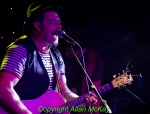 Mad Dog Mcrea and Sound of the Sirens @The Half Moon
Mad Dog Mcrea and Sound of the Sirens @The Half Moon
This was a very special gig. I’d been invited along to see Mad Dog Mcrea and I had no idea about the support on the night, Sound of the Sirens. It’s such a great feeling when you see an artist for the first time and you know instantly that they’re something special. And it’s not just me; apparently Chris Evans was quite impressed with them as well. Anyway, they played a storming set completely winning over the audience with their powerful songs, dynamics, and harmonies. If the night had stopped at that point, I would have been perfectly happy, but we still had Mad Dog Mcrea to come, with an energetic run through material from their album “Almost Home” plus a few old favourites and crowd pleasers. Two great bands with enough in common to appeal to the whole audience but with enough differences to create a very varied night. And there are some photos here.
 Squeeze and Dr John Cooper Clarke @Indigo2
Squeeze and Dr John Cooper Clarke @Indigo2
Another interesting double bill, this time with two very different artists, linked by the era which saw the start of their careers. John Cooper Clarke (now making the most of his honorary doctorate) has been doing poetry and comedy events for a few years but the tour with Squeeze put him back in front of big audiences filled with people who remembered him from the first time round. He throws more one-liners and gags into his routine now but a lot of the old favourite poems are still there, although some of them, particularly “Twat”, have evolved over time. On this night he was a barnstorming crowd-pleaser, building up the audience nicely for the headline act.
This year Squeeze had a new album to promote so the setlist was varied, to say the least, with material covering almost forty years from “Take Me I’m Yours” to new songs like “Cradle to the grave” with the usual smattering of different interpretations of Squeeze classics. What made this performance so special was the group of musicians (mainly Glenn Tilbrook’s Fluffers) now making up the rest of Squeeze who add upright bass, melodica and other esoteric instruments to the mix as well as adding rich vocal harmonies. Chris Difford and Glenn Tilbrook have never sounded better and what an incredible set of songs. Guess what, some photos here.
Graham Parker and Brinsley Schwarz & The Union Chapel
And finally. One of the greatest talents never to break through in the seventies and eighties, Graham Parker, who toured twice this year; once with The Rumour and once with Brinsley Schwarz. With a songbook which again covers almost forty years and a new album to promote as well, Graham Parker mixed up some established classics, some surprises and some new songs to delight an audience which might have been a little biased anyway. His voice is still remarkable and the songs are all strong enough to work in stripped-back arrangements. This wasn’t just a nostalgia thing; there were new songs to promote and they all sounded as good as anything he’s done before. He’s a remarkable man and it was a real pleasure to hear these songs in such a beautiful venue. How about a look at GP in the seventies and now?
 There’s only one band I’ve seen more often than I’ve seen Squeeze (answers in the comments box if you think you know who that is) and one of the interesting things they have in common is that they don’t have a precious attitude about the recorded versions of their songs. Chris Difford and Glenn Tilbrook have always been willing to try new arrangements; I must have heard half a dozen different versions of “Goodbye Girl” over the years and I never heard one I didn’t like. On this tour, Squeeze is basically Glenn’s band The Fluffers plus Melvin Duffy and they all play on the new album “Cradle to the Grave”; each member brings their own particular contribution to the overall sound. Simon Hanson is the archetypal drummer, full of energy and charisma, while his rhythm section partner, Lucy Shaw, dominates the right side of the stage with electric bass, double bass, ukulele and backing vocals. Stephen Large adds keyboards (including accordion and melodica) and Melvin Duffy plays just about anything with strings, including pedal steel and Weissenborn guitar. They’re all wonderful players (and singers) and add layer upon layer of instruments and vocals to the live sound.
There’s only one band I’ve seen more often than I’ve seen Squeeze (answers in the comments box if you think you know who that is) and one of the interesting things they have in common is that they don’t have a precious attitude about the recorded versions of their songs. Chris Difford and Glenn Tilbrook have always been willing to try new arrangements; I must have heard half a dozen different versions of “Goodbye Girl” over the years and I never heard one I didn’t like. On this tour, Squeeze is basically Glenn’s band The Fluffers plus Melvin Duffy and they all play on the new album “Cradle to the Grave”; each member brings their own particular contribution to the overall sound. Simon Hanson is the archetypal drummer, full of energy and charisma, while his rhythm section partner, Lucy Shaw, dominates the right side of the stage with electric bass, double bass, ukulele and backing vocals. Stephen Large adds keyboards (including accordion and melodica) and Melvin Duffy plays just about anything with strings, including pedal steel and Weissenborn guitar. They’re all wonderful players (and singers) and add layer upon layer of instruments and vocals to the live sound.
But what about Dr John Cooper Clarke as support? Well, he’s promoting his new album “Anthologia” and the idea of supporting a band’s nothing new; he did it hundreds of times during the punk era. Nearly forty years on, it still works; there are no musical rivalries between bands to worry about and JCC’s mix of manic recital and laconic links and gags is a perfect way to warm up for the Squeeze hometown gig. The old favourites are there, “Beasley Street”, “Evidently Chickentown” and “Twat” (including verses which weren’t in the original) as well as newer material like “Beasley Boulevard” dealing with the gentrification of inner cities. There’s more chat between poems than in the past and it’s usually hilarious, offering a novel and skewed perspective on everyday life. There’s the occasional stumble in the motormouth delivery, but that’s forgivable and he leaves the audience well and truly ready for the main event.
After an intro from Danny Baker, the set begins with Glenn Tilbrook wandering on stage while playing some intro music which morphs into “Hourglass”, with one of the catchiest of many catchy Squeeze hooks. As you might expect from two people with the experience of Glenn Tilbrook and Chris Difford, the set is perfectly paced, seamlessly weaving three-quarters of the new album in with the old classics and a few surprises. There’s a double hit of nostalgia on this tour as well, because the “Cradle to the Grave” material is set in the early seventies and a few of the songs are already familiar to the audience.
The quality of the band and the range of instruments they play allows for an incredibly varied set musically and visually; everyone sings and they’re able to vary the dynamics of the set by having the entire band along the front of the stage (and even into the audience) a couple of times for a more intimate acoustic feel. The performances are all absolutely spot on but there’s a hugely contagious enthusiasm at play as well. Everyone on stage is having a great time, and who wouldn’t, working your way through some of the finest pop songs ever written. There’s even a couple of non-originals too; The Tom T Hall classic “Harper Valley PTA” gets an energetic run through while Chris takes a lead vocal on a laconic version of Tom Waits’ “I Don’t Wanna Grow Up”. As for the hits, “Hourglass”, “Is That Love?”, “Another Nail in my Heart”, “Tempted”, “Pulling Mussels from the Shell” and “Up the Junction” are all fairly close to the originals while an intimate hits section in the middle of the set has a zydeco version of “Slap and Tickle”, an acoustic version of “Goodbye Girl” with congas, and stripped back acoustic version of “Black Coffee In Bed”.
Hearing those catchy, inventive melodies and clever but under-stated lyrics again is a reminder of the importance of this band to a whole generation in the UK, evoking a time when life wasn’t necessarily better but it was a lot simpler and the soundtrack was superb. You still have five chances to see them on the UK leg of their tour and “Cradle to the Grave” is available now as well. This might just be the time to re-acquaint yourself with two of British pop’s finest writers.
And here’s a coincidence; the only band that I’ve seen more times than Squeeze has two members who are big fans of Chris and Glenn. Who could they be?
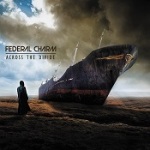 Difficult second album? Not having that; this is Federal Charm we’re talking about here and this is just another step on the way on the way to blues/rock domination. It’s been over two years since the debut album and they haven’t wasted that time. They’ve toured on their own and as support for the likes of Ian Hunter and Rich Robinson, working on the songs at their own pace between tours until they were confident that everything was ready to go. It’s a lot like the live performances; it’s not about pyrotechnics or twenty-minute guitar solos, it’s about four very good musicians playing a bunch of well-crafted songs. The confidence in their own abilities shines through without coming over as the cocksure arrogance of some lesser bands; they don’t need that kind of ego trip. But what about the album?
Difficult second album? Not having that; this is Federal Charm we’re talking about here and this is just another step on the way on the way to blues/rock domination. It’s been over two years since the debut album and they haven’t wasted that time. They’ve toured on their own and as support for the likes of Ian Hunter and Rich Robinson, working on the songs at their own pace between tours until they were confident that everything was ready to go. It’s a lot like the live performances; it’s not about pyrotechnics or twenty-minute guitar solos, it’s about four very good musicians playing a bunch of well-crafted songs. The confidence in their own abilities shines through without coming over as the cocksure arrogance of some lesser bands; they don’t need that kind of ego trip. But what about the album?
Well, the opening song on “Across the Divide”, “Master Plan”, gives a pretty good idea of what the album’s about. It powers in with a mighty guitar riff but this is a long way away from leaden-footed four to the floor dad rock. Even within the first song there are twists and turns, breakdowns and full range of dynamics. And it’s not just about the two guys upfront with the guitars; LD Morawski’s bass and Danny Rigg’s drums play a vital part in the overall sound, as the drummer deals with shifting rhythms and the bass is used as a third guitar, contributing melodic parts (“Silhouette”) rather than the thudding root note we hear way too often.
The big guitar riffs are all there, from the opening chord riff of “Guess What” to the riff and melody combination of the lead track “Hercules”, the wah-wah psychedelia of “No More” and the toppy, choppy riff of the funky “Push” (with the lead vocal sounding a lot like Glenn Tilbrook), Nick Bowden and Paul Bowe’s guitars form constantly shifting patterns under Nick’s stunning vocals. Federal Charm sound just as convincing with the slower songs; “These Four Walls” is a powerful break-up song and the album’s closer, “Walk Away (Time & Time Again)” works its way up through the gears towards a solo which sounds like vintage Brian Robertson before fading out on a piano coda.
“Across the Divide” confirms the impression created by the debut album; these guys have all the ability and all the songs plus the confidence to get out there and deliver where it really counts. They’re currently on the road with Joanne Shaw Taylor before setting out on their own headline tour; get out and see them, you won’t regret it.
“Across the Divide” is out now on Wire-Sound (WIRED 35).
Last Friday I had the opportunity to spend some time with the legendary Southside Johnny before the final show of his UK tour, featuring Gary “US” Bonds, at Shepherds Bush Empire. He was entertaining and engaging (as always):
AM – We did an interview here three and a half years ago and at that time you spoke to me about this acoustic thing that you might or might not be doing, which was really big news at the time and that’s happened now, so how’s that going?
SJ – It’s really good, it’s a fun thing. It’s really stripped down; we travel in a van together, we have breakfast in the morning as a band (there’s only six of us, with the road manager) and we set up our own equipment and tear it down and it really feels like the old days when you used to have to do that. It was a complete commitment to the whole day of travel, set up, play, tear down and travel again and even though I’m kinda long in the tooth I really enjoy it because it seems so organic and basic; there’s no star turns at all. I love playing acoustic music and it gives us a chance to play George Jones and Emmylou Harris and Bob Dylan and Tom Waits and some Bruce in a different format.
AM – You mentioned a few country artists there; you’ve always been a country fan haven’t you?
SJ – Yes I liked country when I was very young. What I didn’t know is that my mother, way back in the thirties when the ukulele was the big thing, she bought a ukulele from Sears Roebuck and she would sit on the porch with her father (her mother had died young) and some neighbours, and they would sing country songs, so I guess it’s in my blood, it’s the Irish part of me.
AM – I’ve heard you play “He’ll Have to Go” (country classic made popular by Jim Reeves) at The Astoria, I think.
SJ – Well, Soozie Tyrell, who plays violin with Bruce, she has a country band in New York City, and I would go up and do lots of songs with her because they’re real singer’s songs, they’re story songs with great melodies so it’s fun to make that kind of music.
AM – The old Jukes revolving door seems to have slowed down a little…
SJ – Not too much. We’ve got a new saxophone player, John Isley; I think (drummer)Tom Seguso’s been over here.
AM – At the time of the last interview, Joey (Stann, tenor sax) and Ed (Manion, baritone sax) were still with you but they’re obviously off doing other things now. There seems to be lots of side projects going on as well now that the New York Horns have made a record.
SJ – These days it’s a lot easier to make a record for a little money and it’s also easier to manufacture; for a buck apiece you can make as many CDs as you want and there’s a profit margin once you’ve paid for the studio time and the musicians and all the rest of it. I’m lucky that Jon Bon Jovi lets me use his studio but, even if he didn’t, studio time’s not as expensive as it used to be, home recording’s easier and the internet makes it easy to get distribution to all your fans round the world. It’s a good time to be a musician because you can do all the little things you want to do without incurring great expense.
AM – Did the side projects always happen to a certain extent; do we just hear about them more because of social media?
SJ – We’ve always done those things; Bobby (Bandiera, guitar, now playing with Bon Jovi) and I went out for months, here and there, doing a lot of charity gigs and they put us on a plane, in business class, just him and me and a guitar and harmonicas. We went all over and played charity things and it was just a chance to play in hotels and every little place you could find and it was a lot of fun because it was no stress.
AM – I saw you at Sheffield City Hall in 1995, I think, just the two of you doing the stripped back thing and it was a great night.
SJ – Well, if you have confidence in what you’re doing and you have material you think you can accomplish with just a guitar and a harmonica it’s a chance to explore all that too. Years ago Bobby, Rusty Cloud, David Hayes and I played in Paris at the Chesterfield Club. We did a two-week stint there with very little publicity and we rode the Métro and that was a lot of fun too. We all stayed in the same hotel, this funky little place and it was two weeks in Paris. I’m lucky I’ve had the chance to do those things and just explore what making music means other than pedal-to-the-metal trying to earn a living. I can do just about anything I want now. I’m never going to be rich, I’ve known that from the very beginning so there’s not a great stress to be a big star and make a lot of money; I make a living and that’s all I want. I just want to be allowed to do whatever kind of music I want to make.
AM – I was going through some of my very old Jukes records today and it struck me that after Billy Rush left, you got much more involved in the songwriting process; there’s not a lot of your songs on the early albums.
SJ – I was a writer back then but I would write certain things with certain people but the bulk of the song would be theirs and I’d say “forget it, I don’t want to have anything to do with it”. I wrote with Billy but I don’t have the kind of ego that I need to see my name on the album, but now with Jeff and Bobby the songwriting is really a collaboration so I get to write a lot of lyrics that I find interesting like “Into the Harbour” and “Winter in Yellowknife” and stuff like that which is not the norm for romantic love songs.
AM – On “Pills and Ammo”, it struck me that your name’s on every track as a writer. Do you have a certain way of working; do you do the lyrics and Jeff does the music?
SJ – It’s pretty much that way except that if I come up with a musical idea we’ll explore it and he helps me with lyrics; it’s a real collaboration in other words. I’ll come with an idea, a whole lyric and I’ll say “I think it sounds like this” and he’ll find a way to make it sound like what I want, but then he’ll say “what about this…” and we really try to bounce ideas off each other.
AM – I know Jeff’s a big fan of Squeeze and Difford and Tilbrook wrote in that way as well.
SJ – I’m a big Squeeze fan too.
AM – About your audiences; you’ve retained a very loyal audience in the UK. In the US, are the audiences different?
SJ – Well, they speak English. There’s people who come and see us a million times and there’s people who come and see us for the first time and usually we can win people over. It’s the energy and a lot of the music is made to lift you up so it’s not some shoegazer and it’s not some egomaniac, it’s really just music. I think one of the things that keeps people coming back is that it’s never the same night after night and I don’t know where it’s going to go and tonight’s going to be like that too because we’ve got Gary Bonds and we know what we’re going to do but when we get on stage, that may change.
AM – I’ve been watching Billy Walton live for a while and I’ve noticed that his crowd seems to be getting younger. I’ve seen teenagers at his shows but I’ve also seen people in their twenties who know all of the songs. I just wondered if that was happening with The Jukes.
SJ – We do get a lot of younger people; we had a bunch last night in Holmfirth, but we have our loyal fans and they’re the ones that usually get the first tickets and they’re older, but they bring their kids and some of them bring their grand-kids but anybody who’s willing to give us a shot we’re willing to play for as long as they come and have a good time and just enjoy themselves.
AM – November used to be the traditional time for a Jukes tour but the last couple of years you’ve been over during the summer. I’m guessing that’s because of festivals.
SJ – Yes. This year especially, because we had the Cornbury Festival to start it and we’re ending with Bospop in Holland so we had two festivals and we put a bunch of gigs in between and those get to be the anchor gigs. Unfortunately there’s new taxes in England, Foreigner Entertainer Tax (FET) and Hood, who settles everything got hit with it the other night and they wanted £1,400 for FET. Nobody knew exactly what it was but it’s legitimate and all that does is it makes it harder for bands like me to come over here; you can only lose so much money. On the one hand I guess they need the tax money but if they really need that, they should get all those people who hide their money offshore and let us poor bands try to play a little music.
AM – And a lot of musicians are hiding money offshore.
SJ – Well I’m not hiding any money; my money comes and goes and I get to see it as it goes past and that’s about it.
AM – Going back to the festivals, what’s the biggest gig you’ve ever played?
SJ – Probably Knebworth with Led Zeppelin. We did two shows; we did the first one, flew home and did a show in Washington DC, flew back and did the second show at Knebworth and flew home again, if I remember rightly, so it was a lot of flights. And we played about forty minutes but it was fun, it was a unique experience and we met some good people over here.
AM – As far as I can remember, and I was a long way away from the stage, it seemed like you got a pretty good response that day.
SJ – It seemed like that; of course we didn’t the full power that the headline act got (we don’t do that, if somebody opens up for us they get full power, but I’m not ever worried about a band opening up for us, I hope they do well). But I thought Led Zeppelin was terrible; there was no bass in the mix in the audience.
AM – That’s all the serious stuff but I’ve got couple of other questions for you. You’ve now got a huge body of work to choose from when you play; is there anything you feel can’t be left out?
SJ – Well, there’s nothing that can’t be left out, but I’m not there to just indulge myself, I’m there to give people what they want too and you split the difference. I know they want to hear “I Don’t Want to Go Home” and “The Fever” and “Trapped Again” or “Talk to Me” or “This Time It’s for Real” or “Love on the Wrong Side of Town” or whatever and you try to include those but when you twenty-two, twenty-three songs, there’s plenty of room for you to do what you want too. There are times when I say “I’m sick of this song, I’m not doing it” and it lasts for few months then it’s back in.
AM – Here’s one from my sister, who’s a big fan. Is there a song that makes you cry?
SJ – There’s a lot I guess. I’ve got some that I’ve written but Alison Krauss does a song called “I Can Let Go Now” which I think was written by Michael McDonald and it just kills me because I relate it to my mother. I don’t think that’s what it’s really about but for me it is and I just can’t listen to that song. There’s a lot; there are things that really touch me. I wouldn’t be doing if I didn’t get emotionally involved. When I was young and heard certain songs, I either got happy or excited or even felt sexy or touched, and to be part of that tradition is an amazing thing, but I’ve never really lost the idea that if someone sings a great song and really means it then I can get lost in the emotion.
AM – I find it really difficult to listen to “Many Rivers to Cross” after the version Jeff did here in 2010.
SJ – He really puts his heart and soul into it.
AM – Finally, hoping for another scoop, have you get anything in the pipeline?
SJ – Well, Jeff and I have written most of the songs for the next Jukes album; when we get it finished, I don’t know. We’re hoping to get in the studio, perhaps this winter and get it out some time next year. I’d love to get it out by Christmas but that’s just not gonna happen, and I’ve written some songs for a new Poor Fools acoustic thing and I’ve got a couple of other projects in mind too. I could retire if I wanted to, but then what would I do? I’d sit around the house, get fat and drink myself to death, and I can do that on the road.
AM – Johnny, many thanks for making the time for the interview.
SJ – My pleasure, any time.


